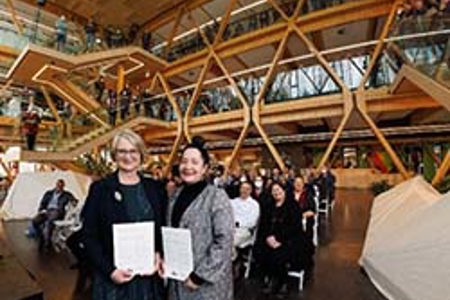
A partnership has been cemented with the signing of a Kawenata/Memorandum of Understanding between tangata whenua and Scion at Te Whare Nui o Tuteata in Rotorua recently.
Veronica Butterworth, a trustee representing the three hapū - Ngāti Hurungaterangi, Ngāti Taeotu and Ngāti Te Kahu (Ngā Hapū e Toru) signed the Kawenata with Scion board Chair Dr Helen Anderson.
Ngā Hapū e Toru are tangata whenua of the 114-hectare site where Scion is situated in the Te Papa Tipu campus.
Ms Butterworth says the signing for Ngā Hapū e Toru is a significant step forward in the partnership with Scion, which in turn is a step towards strengthening the mana of the land and hapū.
“The Kawenata acknowledges the genealogical connection through our whakapapa to this land. This land is part of our rohe, our turangawaewae, and is the basis of identity and wellbeing for our people.
“Working together with Scion to honour this Kawenata, we will work on mutually beneficial goals. The matapono (principles) of the Kawenata are whakapapa, kotahitanga, rangatiratanga, manaakitanga and tiakina te mana o te whenua.”
Scion chair Dr Helen Anderson says the signing marks a significant milestone for the Crown Research Institute and its enduring relationship with tangata whenua.
“We are signalling how Scion and tangata whenua recognise the value of working together in the spirit of cooperation and partnership. We have common principles and an unwavering commitment to protect the waterways, forests and whenua.
“As Scion takes bold new steps with research to support New Zealand’s transition to a circular bioeconomy as part of efforts to meet climate change objectives, we are committing to a set of principles that will underpin our close relationship with tangata whenua and help us navigate the challenges and opportunities ahead.”
The signing was followed by the launch of a new permanent visitor display in the building’s atrium, sharing the history and connection that Ngā Hapū e Toru have to the whenua, while also explaining the significance of forestry science and innovation to New Zealand and the world.
Co-funded by Scion and Te Uru Rākau, New Zealand Forest Service, the displays are a creative storytelling experience that share the history of tangata whenua, forestry, and the future.
One display describes Ngāti Hurungaterangi, Ngāti Taeotu and Ngāti Te Kahu. It explains the deep connection to the whenua, with historical pā, kāinga, cultivations and wāhi tapu (sacred sites), as well as looking to hapū aspirations – including partnership.
The other display documents the history of New Zealand’s forestry industry, starting in the late 19th century when the first exotic trees were planted in a nursery at the Whakarewarewa Forest. The storytelling dives deep on the value of radiata pine, along with the importance of forests to New Zealand for timber production, biodiversity, biomaterials, tourism and to tackle climate change problems the world faces.









